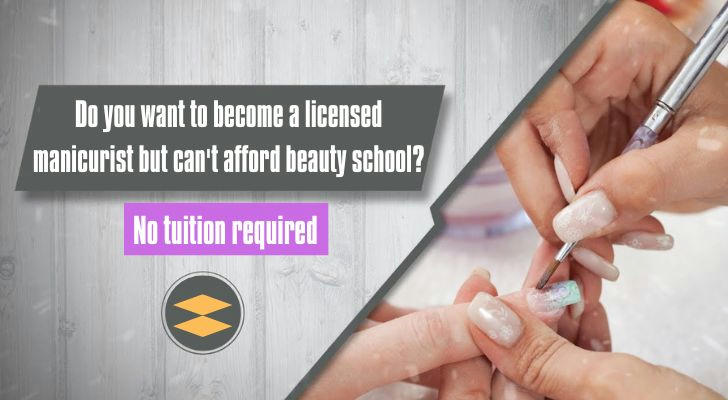Become a Licensed Nail Technician Without Paying Tuition: Understanding Nail Apprenticeships in the U.S.
In the United States, becoming a licensed manicurist doesn’t always require enrolling in an expensive beauty school. For those who are passionate about nails but unable to afford tuition, nail apprenticeship programs offer a practical, structured, and legal pathway into the beauty industry—sometimes even with paid opportunities.
This guide breaks down how nail apprenticeships work, who they benefit, and includes two real stories of individuals who started with no experience and are now licensed professionals.

What Is a Nail Apprenticeship?
A nail apprenticeship is a form of vocational training where individuals work under the supervision of a licensed nail technician or salon owner. Instead of learning in a classroom, apprentices train directly in a working salon environment. Over time, they build the skills and hours required to sit for the state licensure exam.
Common Components of a Nail Apprenticeship:
Practical Skill-Building: Training on real clients, covering services like shaping, polishing, gel application, and nail art.
Theoretical Study: Topics include nail anatomy, sanitation, infection control, and local licensing laws.
Customer Service: Learning to communicate effectively and build rapport with clients.
Structured Pay Options: Some apprenticeships offer hourly pay or commission-based earnings while learning.
Why Choose an Apprenticeship Over Traditional Cosmetology School?
| Feature | Apprenticeship | Beauty School |
|---|---|---|
| Tuition Fees | Often none | Ranges from $5,000–$20,000+ |
| Learning Environment | Real salon, real clients | Mostly classroom or peer-based |
| Schedule Flexibility | Often adjustable | Typically fixed class hours |
| Income Opportunities | Possible paid work during training | Usually unpaid during school |
| Licensing Pathway | Approved by state boards | Standard path |
For example, Heather’s Nail Boutique in Virginia Beach offers a paid apprenticeship program. Participants receive hands-on experience, study support, and a structured timeline—typically between 12 to 18 months—to complete their training and become licensed, without incurring tuition debt.
Real Case Study 1: From Retail Worker to Licensed Nail Tech in 18 Months
Name: Brittany T.
Age: 29
Location: Atlanta, Georgia
Background: A single mother working retail jobs with little career growth.
Program: Heather’s Nail Boutique Paid Apprenticeship
Experience:
Trained 3–4 days a week in a salon, working directly with clients.
Studied theory and licensing requirements during evenings.
Began performing full gel manicure services independently within 9 months.
Outcome:
After 18 months, Brittany passed the state licensing exam. She now works full-time at the same salon, has doubled her income, and maintains a flexible schedule that allows her to care for her child.
Real Case Study 2: Male Nail Artist Builds Niche Clientele in Texas
Name: Chris R.
Age: 32
Location: Houston, Texas
Background: Former warehouse worker interested in nail design but unsure how to enter the industry.
Program: Polished Looks Nail Salon Apprenticeship
Experience:
Learned under licensed professionals, starting with basic shaping and progressing to advanced nail design.
Promoted his services through social media with salon support, focusing on men’s grooming.
Built a regular clientele of over 20 male clients during the apprenticeship.
Outcome:
After completing 1,000 apprenticeship hours and passing the Texas licensure exam, Chris now works full-time as a men's nail specialist. His monthly income exceeds $4,000, and he is planning to open his own studio.
How to Apply for a Nail Apprenticeship
Check Your State’s Licensing Requirements: Regulations vary by state. States like Georgia, California, and Texas allow apprenticeship hours toward licensure.
Search for Opportunities: Use search terms like “nail apprenticeship near me” on Google, Instagram, or Facebook. Visit salon websites to look for official programs.
Prepare Your Application: Include a professional resume and a short personal statement explaining your interest in nail care.
Attend Interviews: Demonstrate your commitment to learning and professionalism.
Understand the Terms: Most programs require a formal agreement outlining your responsibilities, required hours, and compensation structure.
Who Is a Good Fit for This Path?
Individuals unable to afford cosmetology school tuition
People looking for hands-on, practical experience over theory-heavy instruction
Career changers seeking a flexible, creative job
Single parents or caregivers who need a learn-as-you-work schedule
Those who thrive in a salon environment and want to learn by doing
Final Thoughts
The nail apprenticeship route offers a meaningful, cost-effective way to enter the beauty industry without taking on the financial burden of traditional education. For many, it opens doors to a fulfilling, stable, and creative profession in under two years.
If you're considering a career in nail care, researching local apprenticeship programs could be the first step toward building a professional future—on your own terms, and at your own pace.
